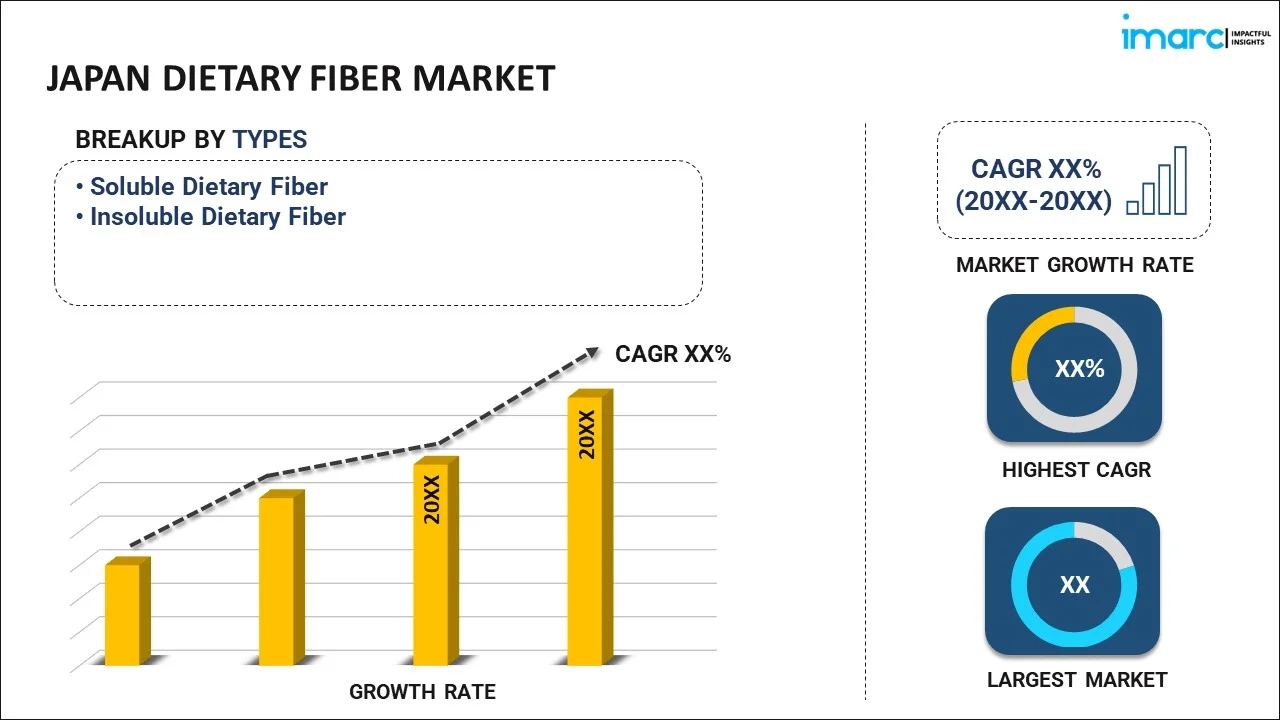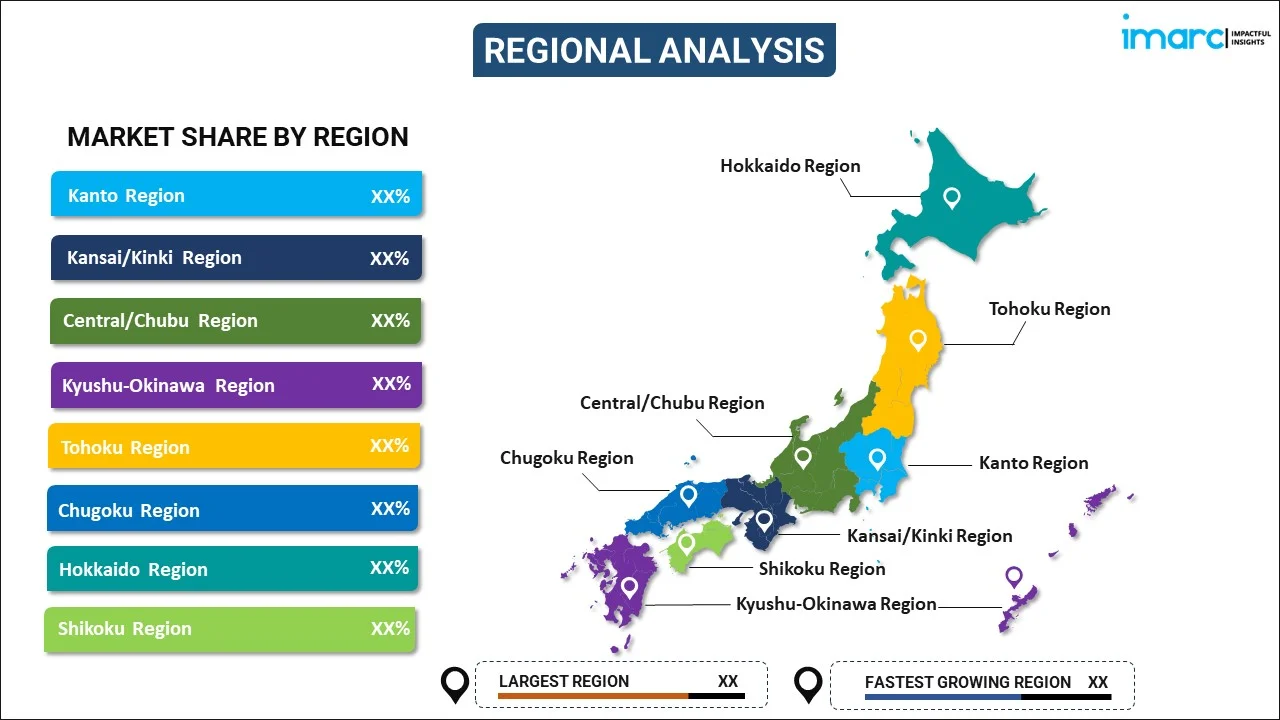
Japan Dietary Fiber Market Report by Type (Soluble Dietary Fiber, Insoluble Dietary Fiber), Source (Fruits and Vegetables, Cereals and Grains, Legumes, Nuts and Seeds), Application (Functional Foods and Beverages, Pharmaceuticals, Animal Feed, and Others), and Region 2026-2034
Market Overview:
Japan dietary fiber market size reached USD 614.4 Million in 2025. Looking forward, IMARC Group expects the market to reach USD 1,105.6 Million by 2034, exhibiting a growth rate (CAGR) of 6.75% during 2026-2034. The market is witnessing growth due to various factors including the increasing recognition of the health advantages linked to dietary fiber intake, a rising inclination towards health-conscious dietary choices among individuals, positive public health campaigns and dietary recommendations, and multiple advancements in food technology.
|
Report Attribute
|
Key Statistics
|
|---|---|
|
Base Year
|
2025
|
|
Forecast Years
|
2026-2034
|
|
Historical Years
|
2020-2025
|
|
Market Size in 2025
|
USD 614.4 Million |
|
Market Forecast in 2034
|
USD 1,105.6 Million |
| Market Growth Rate 2026-2034 | 6.75% |
Dietary fiber is a crucial element primarily sourced from plant-based foods, renowned for its ability to promote digestive well-being. It constitutes a complex carbohydrate that remains undigested within the human body, yet plays a pivotal role in maintaining a healthy digestive system. Comprising both soluble and insoluble forms, dietary fiber fulfills several functions, including facilitating digestion, aiding in weight management, and contributing to a reduced risk of ailments such as diabetes and heart conditions. Soluble fiber dissolves in water, creating a gel-like substance that assists in lowering cholesterol levels and stabilizing blood sugar. Conversely, insoluble fiber promotes the movement of material through the digestive tract and enhances stool bulk.
Japan Dietary Fiber Market Trends:
The Japan dietary fiber market is experiencing significant growth, driven by a confluence of factors that underscore the increasing importance of dietary fiber in the context of health and nutrition. One of the primary drivers is the growing awareness among the Japanese population about the myriad health benefits associated with dietary fiber consumption. As individuals become more health-conscious, there is a notable shift towards adopting dietary habits that prioritize fiber-rich foods. Furthermore, public health initiatives and nutritional guidelines that emphasize the importance of incorporating dietary fiber into daily diets have played a pivotal role in propelling the market forward. These initiatives serve as educational tools, informing consumers about the advantages of dietary fiber in promoting digestive health, supporting weight management, and reducing the risk of chronic diseases like diabetes and heart conditions.
In addition to the growing awareness and favorable public health campaigns, the market is benefiting from ongoing innovations in food technology. Food manufacturers in Japan are increasingly incorporating dietary fiber into various food products, including baked goods, cereals, snacks, and beverages, to meet the rising demand for fiber-enriched options. Overall, the Japan dietary fiber market is on a robust growth trajectory over the forecasted period.
Japan Dietary Fiber Market Segmentation:
IMARC Group provides an analysis of the key trends in each segment of the market, along with forecasts at the country level for 2026-2034. Our report has categorized the market based on type, source, and application.
Type Insights:

- Soluble Dietary Fiber
- Inulin
- Pectin
- Polydextrose
- Beta-glucan
- Others
- Insoluble Dietary Fiber
- Cellulose
- Hemicellulose
- Chitin and Chitosan
- Lignin
- Fiber/Bran
- Resistant Starch
- Others
The report has provided a detailed breakup and analysis of the market based on the type. This includes soluble dietary fiber (inulin, pectin, polydextrose, beta-glucan, and others) and insoluble dietary fiber (cellulose, hemicellulose, chitin and chitosan, lignin, fiber/bran, resistant starch, and others).
Source Insights:
- Fruits and Vegetables
- Cereals and Grains
- Legumes
- Nuts and Seeds
A detailed breakup and analysis of the market based on the source have also been provided in the report. This includes fruits and vegetables, cereals and grains, legumes, and nuts and seeds.
Application Insights:
- Functional Foods and Beverages
- Pharmaceuticals
- Animal Feed
- Others
The report has provided a detailed breakup and analysis of the market based on the application. This includes functional foods and beverages, pharmaceuticals, animal feed, and others.
Regional Insights:

- Kanto Region
- Kansai/Kinki Region
- Central/ Chubu Region
- Kyushu-Okinawa Region
- Tohoku Region
- Chugoku Region
- Hokkaido Region
- Shikoku Region
The report has also provided a comprehensive analysis of all the major regional markets, which include Kanto Region, Kansai/Kinki Region, Central/ Chubu Region, Kyushu-Okinawa Region, Tohoku Region, Chugoku Region, Hokkaido Region, and Shikoku Region.
Competitive Landscape:
The market research report has also provided a comprehensive analysis of the competitive landscape in the market. Competitive analysis such as market structure, key player positioning, top winning strategies, competitive dashboard, and company evaluation quadrant has been covered in the report. Also, detailed profiles of all major companies have been provided. Some of the key players include:
- Ingredion Incorporated
- J. Rettenmaier & Söhne GmbH + Co KG
- Nexira
- Otsuka Pharmaceutical Co. Ltd.
- Roquette Frères
(Please note that this is only a partial list of the key players, and the complete list is provided in the report.)
Japan Dietary Fiber Market Report Coverage:
| Report Features | Details |
|---|---|
| Base Year of the Analysis | 2025 |
| Historical Period | 2020-2025 |
| Forecast Period | 2026-2034 |
| Units | Million USD |
| Scope of the Report | Exploration of Historical and Forecast Trends, Industry Catalysts and Challenges, Segment-Wise Historical and Predictive Market Assessment:
|
| Types Covered |
|
| Sources Covered | Fruits and Vegetables, Cereals and Grains, Legumes, Nuts and Seeds |
| Applications Covered | Functional Foods and Beverages, Pharmaceuticals, Animal Feed, Others |
| Regions Covered | Kanto Region, Kansai/Kinki Region, Central/ Chubu Region, Kyushu-Okinawa Region, Tohoku Region, Chugoku Region, Hokkaido Region, Shikoku Region |
| Companies Covered | Ingredion Incorporated, J. Rettenmaier & Söhne GmbH + Co KG, Nexira, Otsuka Pharmaceutical Co. Ltd., Roquette Frères, etc. |
| Customization Scope | 10% Free Customization |
| Post-Sale Analyst Support | 10-12 Weeks |
| Delivery Format | PDF and Excel through Email (We can also provide the editable version of the report in PPT/Word format on special request) |
Key Benefits for Stakeholders:
- IMARC’s industry report offers a comprehensive quantitative analysis of various market segments, historical and current market trends, market forecasts, and dynamics of the Japan dietary fiber market from 2020-2034.
- The research report provides the latest information on the market drivers, challenges, and opportunities in the Japan dietary fiber market.
- Porter's five forces analysis assist stakeholders in assessing the impact of new entrants, competitive rivalry, supplier power, buyer power, and the threat of substitution. It helps stakeholders to analyze the level of competition within the Japan dietary fiber industry and its attractiveness.
- Competitive landscape allows stakeholders to understand their competitive environment and provides an insight into the current positions of key players in the market.
Key Questions Answered in This Report
The dietary fiber market in Japan was valued at USD 614.4 Million in 2025.
The Japan dietary fiber market is projected to exhibit a CAGR of 6.75% during 2026-2034, reaching a value of USD 1,105.6 Million by 2034.
The market is witnessing substantial growth, driven by increasing consumer awareness regarding digestive health and wellness, increasing demand for functional and fortified foods, and growing adoption of health-conscious eating habits. The expanding processed and packaged food industry, coupled with an aging population seeking improved nutrition, supports market growth.
Some of the major players in the Japan dietary fiber market include Ingredion Incorporated, J. Rettenmaier & Söhne GmbH + Co KG, Nexira, Otsuka Pharmaceutical Co. Ltd., Roquette Frères, etc.
Need more help?
- Speak to our experienced analysts for insights on the current market scenarios.
- Include additional segments and countries to customize the report as per your requirement.
- Gain an unparalleled competitive advantage in your domain by understanding how to utilize the report and positively impacting your operations and revenue.
- For further assistance, please connect with our analysts.
 Request Customization
Request Customization
 Speak to an Analyst
Speak to an Analyst
 Request Brochure
Request Brochure
 Inquire Before Buying
Inquire Before Buying




.webp)




.webp)












